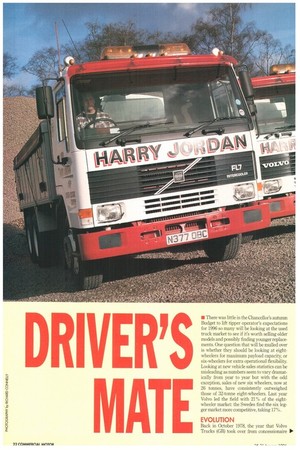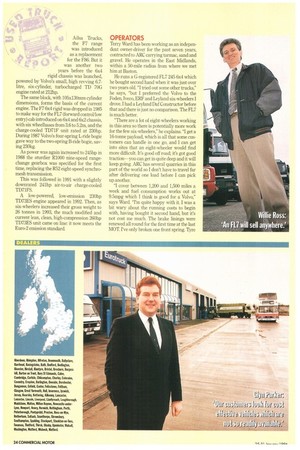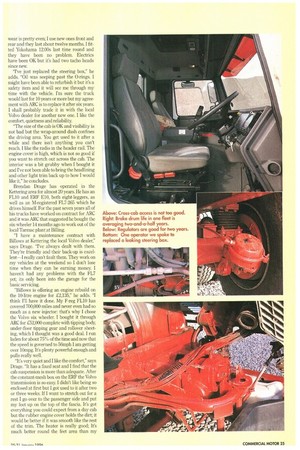DRI V E R M ATE
Page 24

Page 26

Page 27

Page 28

Page 29

If you've noticed an error in this article please click here to report it so we can fix it.
• There was little in the Chancellor's autumn Budget to lift tipper operator's expectations for 1996 so many will be looking at the used truck market to see if it's worth selling older models and possibly finding younger replacements. One question that will be mulled over is whether they should be looking at eight. wheelers for maximum payload capacity, or six-wheelers for extra operational flexibility. Looking at new vehicle sales statistics can be misleading as numbers seem to vary dramatically from year to year but with the odd exception, sales of new six wheelers, now at 26 tonnes, have consistently outweighed those of 32-tonne eight-wheelers. Last year Volvo led the field with 21% of the eightwheeler market: the Swedes find the six legger market more competitive, taking 17%.
EVOLUTION
Back in October 1978, the year that Volvo Trucks (GB) took over from concessionaire Ailsa Trucks, the F7 range
414 was introduced 4009011. as a replacement -4! yji • for the F86 But it was another two years before the 6x4 rigid chassis was launched, powered by Volvo's small, high revving 6.7litre, six-cylinder, turbocharged TD 70G engine rated at 212hp.
The same block, with 105x130mm cylinder dimensions, forms the basis of the current engine. The F7 6x4 rigid was dropped in 1985 to make way for the FL7 (forward controlllow entry) cab introduced on 6x4 and 6x2 chassis, with six wheelbases from 3.6 to 5.2m, and the charge-cooled TD71F unit rated at 230hp. During 1987 Volvos four-spring L-ride bogie gave way to the two-spring B-ride bogie, saving 230kg.
As power was again increased to 245hp in 1988 the sturdier R1000 nine-speed rangechange gearbox was specified for the first time, replacing the R52 eight-speed synchromesh transmission.
This was followed in 1991 with a slightly downrated 241hp air-to-air charge-cooled TD71FS.
A low-powered, low-emission 230hp TD73ES engine appeared in 1992. Then, as six-wheelers increased their gross weight to 26 tonnes in 1993, the much modified and current lean, clean, high-compression 260hp TD73ES unit came on line: it now meets the Euro-2 emission standard.
OPERATORS
Terry Ward has been working as an independent owner-driver for the past seven years, contracted to ARC carrying tarmac, sand and gravel. He operates in the East Midlands, within a 50-mile radius from where we met him at Baston.
He runs a G-registered FL7 245 6x4 which he bought second hand when it was just over two years old. "I tried out some other trucks," he says, "but I preferred the Volvo to the Foden, Iveco, ERF and Leyland six-wheelers I drove.! had a Leyland Daf Constructor before that and there is just no comparison. The FL7 is much better.
"There are a lot of eight-wheelers working in this area so there is potentially more work for the few six-wheelers," he explains. "I get a 16-tonne payload, which is all that some customers can handle in one go, and I can get into sites that an eight-wheeler would find more difficult. It's good off road; it's got good traction—you can get in quite deep and it will keep going. ARC has several quarries in this part of the world so I don't have to travel far after delivering one load before I can pick up another.
"I cover between 1,200 and 1,500 miles a week and fuel consumption works out at 9.5mpg which I think is good for a Volvo," says Ward. "I'm quite happy with it. I was a bit wary about the running costs to begin with, having bought it second hand, but it's not cost me much. The brake linings were renewed all round for the first time at the last MOT I've only broken one front spring. Tyre wear is pretty even: I use new ones front and rear and they last about twelve months. I fitted Yokohama 12.00s last time round and they have been no problem. Electrics have been OK but it's had two tacho heads since new.
"I've just replaced the steering box," he adds. "Oil was seeping past the 0-rings. I might have been able to refurbish it but it's a safety item and it will see me through my time with the vehicle. I'm sure the truck would last for 10 years or more but my agreement with ARC is to replace it after six years. I shall probably trade it in with the local Volvo dealer for another new one. I like the comfort, quietness and reliability.
"The size of the cab is OK and visibility is not bad but the wrap-around dash confines the driving area. You get used to it after a while and there isn't anything you can't reach, I like the radio in the header rail. The engine cover is high, which is not so good if you want to stretch out across the cab. The interior was a bit grubby when I bought it and I've not been able to bring the headlining and other light trim back up to how I would like it," he concludes.
Brendan Drage has operated in the Kettering area for almost 20 years. He has an FL10 and ERF E10, both eight-leggers, as
well as an M-registered FL7-265 which he drives himself. For the past seven years all of
his trucks have worked on contract for ARC and it was ARC that suggested he bought the six-wheeler 14 months ago to work out of the local Tarmac plant at Billing.
"I have a maintenance contract with Billows at Kettering the local Volvo dealer," says Drage. "I've always dealt with them.
They're friendly and their back-up is excel lent I really can't fault them. They work on
my vehicles at the weekend so I don't lose time when they can be earning money. I haven't had any problems with the FL7 yet; its only been into the garage for the basic servicing.
"Billows is offering an engine rebuild on the 10-litre engine for £2,135," he adds. "I think I'll have it done. My F-reg FL10 has covered 700,000 miles and never even had so much as a new injector: that's why I chose the Volvo six wheeler. I bought it through
ARC for £52,000 complete with tipping body, under-floor tipping gear and rollover sheet
ing, which I thought was a good deal. I run laden for about 75% of the time and now that the speed is governed to 56mph Tam getting over lOmpg. It's plenty powerful enough and pulls really well.
"It's very quiet and I like the comfort," says Drage. "It has a fixed seat and I find that the cab suspension is more than adequate. After the constant-mesh box on the ERF the Volvo transmission is so easy. I didn't like being so enclosed at first but I got used to it after two or three weeks. If I want to stretch out for a rest I go over to the passenger side and put my feet up on the top of the fascia. It's got everything you could expect from a day cab but the rubber engine cover holds the dirt; it would be better if it was smooth like the rest of the trim. The heater is really good; It's much better round the feet area than my Volvo eight legger. I would like it even bet ter if it had a plastic header tank, like my FL10, so that I wouldn't have to tilt the cab just to top up the coolant. On the next 6x4 Twill go for an electric roll-over sheet and an automatic tail gate. This one is a bit tall for me. I've clocked up 91,000 miles and I'm on my second set of tyres at the front. I swap them around at the rear and they will be renewed at the end of the month. I don't get much rough site work so they're not so prone to accidental damage.
"Volvo prices hold up well," he concludes.
1 bought my last FL10 for £54,000 and sold it for £35,000 after three years. The FL7 is newer than my other trucks so it's got to be better but it would have to be a very good truck to make me change to something else next time around."
Russel Bateman runs two FL7 265 6x4 tippers for the family firm started by his grandfather Harry Jordan and based at Bagworth, Leics. One is K-registered with a Euro-1 engine; the other is on an N-plate with a Euro 2 unit. "We have run Volvo's for over 15 years," says Bateman. "There might be slightly better trucks about but we can't fault the FL7s and the backup is second to none. We have bought new vehicles for the past seven years and we find that prices are comparable with those of Scania, Renault and Foden.
"A lot of our work is for Redland on aggregates and tarmac," he adds. "We probably run loaded for about 60% of the time; now they've changed the Leicester western bypass and we can get straight out onto the motorway without running through the town, our fuel consumption has improved from under 9mpg to over lOmpg. We expect to replace them after four years. In recent deals we have part exchanged them with Billows at Stoney Stanton. We never get the price we would like but in the end I was more than happy with the deal on the last one. We take advantage of the 12 months' free service and when they come off that! look after the vehicles. Bateman reports: "The worst problem we have had is with the brake drums wear—they're lasting about two-and-a-half years. Volvo is using non-asbestos linings; we had the same trouble when Ferodo brought theirs out a few years ago. The K-reg truck had an axle tube crack and it's been welded up under warranty We're keeping an eye on it and I'm assured that if it gives any more trouble they will replace it. The new trucks are fitted with 315 low-profile tyres on the front.
"They're carrying a bit more weight with the axle now plated at 7.5 tonnes. They don't seem to be wearing any faster but I haven't had them long enough to compare them properly with the 12.00s that we used before. The K-reg vehicle has just had to have a new alternator: the regulator seems to wear out about every two years.
"I have run FL7s for a few years now so I can pick up on problems and solve them very quickly and on the driving side, because we spend a lot of time in the cab, comfort is important," he says. "I've looked at other vehicles working out of the plants and I think that the Volvo just about comes out on top. With the day cab there is a blind spot on the nearside of the cab which in my opinion has been made worse by the new mirrors. Overall the cab is very easy to keep clean.
The rubber mat over the engine is a bit more dimpled than it used to be, he concludes, "and it holds the dirt, but a blast with the air line quickly shifts it."
DEALERS
Willie Ross set up a satellite used truck dealership on the outskirts of Edinburgh for Chaddesley Commercials about three years ago. He carries a stock of some 20 vehicles, mainly Scanias and Volvos on H-plates or later. He finds that the FL7 is very popular as a six-wheel tipper, usually with front-end tipping gear, although he does see the occasional flatbed as well.
"It's a very good truck and not that easy to get hold off," he says. "While some tucks are easier to sell in some parts of the UK than others an FL7 will sell anywhere. The residuals are as high as for any six-wheeler; even the flats fetch a good price." Most of the examples he gets for resale are fitted with the 245hp engine but one or two of the 265s are now becoming available. "Engine life depends on how they have been used and looked after," says Ross. "The cab trim can get a bit tatty on the older ones but they're always popular".
Eurotruck is Scotland's biggest franchised Volvo dealer with parts and service outlets at Perth and Inverness and full dealership facilities in Broxburn and Aberdeen which carry a used stock of some 25 vehicles under five years old. General manager and director Glyn Parker estimates that Volvo accounts for nearly 20% of new six-wheelers sold in Scotland, "The FL7 6x4 is consistently in demand in the used truck market," he reports. "Our customers look for a cost effective vehicles which are not so readily available,
"We sell more new eight-wheelers in the east of Scotland," he adds, "so used FL1Os are easier to obtain while good six-wheelers are few and far between. I would expect a good K-reg FL7 6x4 to fetch between £33,000 and £34,000 with up to 250,000km on the clock. I've seen some with over 500,000km on the clock so there's no worry about the engine if it's treated properly."
SUMMARY
The l'17 has been around for more than 10 years hut, thanks to regular updates, it shows no sign of losing its competitive edge. Users and dealers alike hold this model in high regard: the occasional adverse comments (poor cross-cab access, the need to tilt the cab to top up coolant levels) were swamped by a tide of satisfaction that helps account for a shortage of clean, late examples on the secondhand market.
Eight-leggers may hog the limelight, but if your operation needs manoeuvrability more than maximum payload the FL7 really ought to be on your shortlist. It's been around long enough to be a proven workmate, but has been kept up to date.
As always, good residuals are better news for sellers than buyers, but then good trucks never did come cheap.
Pby Bill Brock
































































































